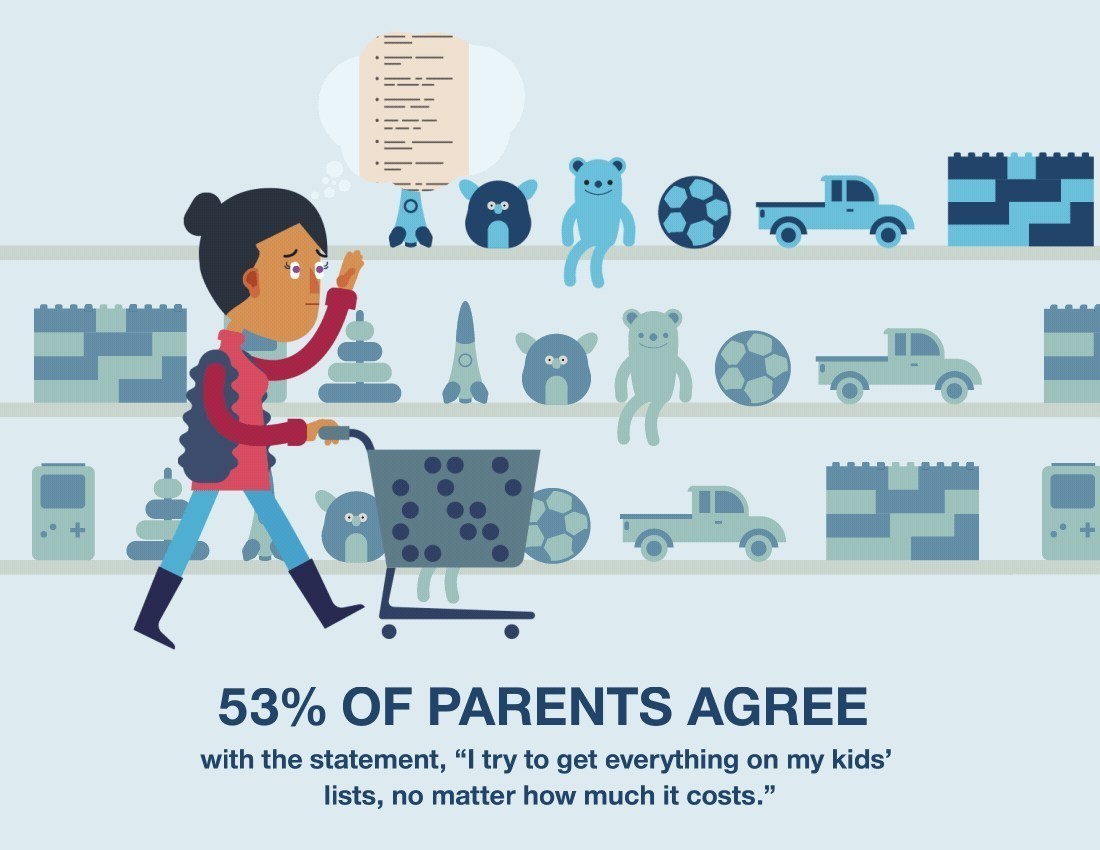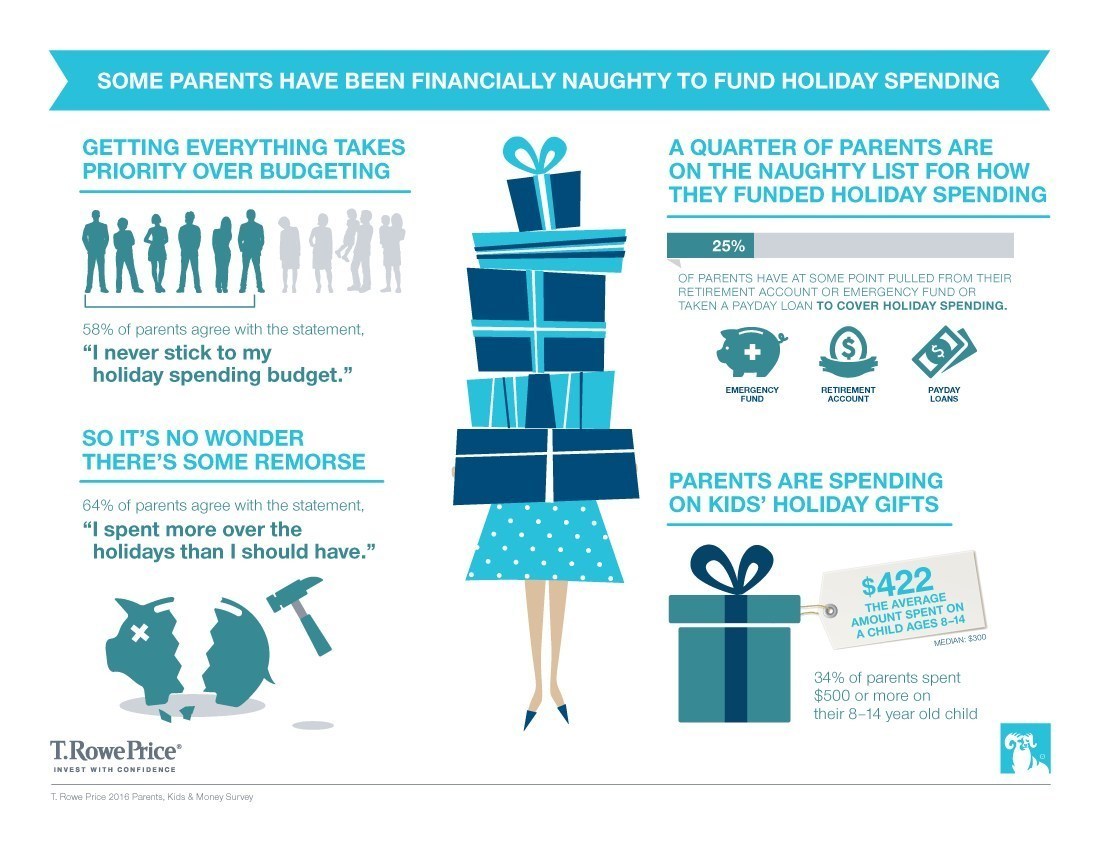Scary statistic – Parents Buying Everything on Children’s Present List

I just saw this press release and it’s scary, especially when getting outdoors is generally free, and a hugely healthy option compared to what many kids ask for on their lists. This article doesn’t tell us what things are asked for by the children but focuses more on the fact that over half of parents got everything they could from their childrens list.
Our advice is, don’t spend as much money, spend more time with your Kids…
T. Rowe Price’s Parents, Kids & Money Survey, which sampled more than 1,000 parents and their 8 to 14 year old kids in February 2016, revealed that many parents are willing to overextend their finances to fulfill their kids’ holiday wish lists. And 25% of parents have either taken from their 401(k)s or their emergency funds or taken a payday loan to cover holiday spending.
Marty Allenbaugh, a CERTIFIED FINANCIAL PLANNER™ at T. Rowe Price, says, “No one wants to be a Scrooge. Between our inclination to be generous during the holiday season and the blockbuster retail deals, playing Santa can be kryptonite for even the savviest budgeters. But splurging a little shouldn’t turn into indulgence at the expense of financial well-being. Retirement accounts are meant to fund retirement. Emergency funds are meant to fund emergencies. Payday loans should be the last of last resorts. Nothing that comes wrapped in a ribbon is worth the consequence of bending these rules.”
As an example of the potential long-term impact of pulling from retirement savings, a 35 year old taking a distribution from her 401(k) to cover $500 in holiday spending could be sacrificing nearly $6,000 at retirement.*
Mr. Allenbaugh continues, “On top of the financial cost, there is also an opportunity cost that comes with checking off everything on kids’ wish lists. Prioritizing wants and making trade-offs teach kids valuable money lessons that are missed if parents take an everything-or-bust approach to holiday shopping.”
T. Rowe Price encourages parents to invest in their kids’ futures by talking to them weekly about money matters, such as saving and spending wisely. To help, the firm created MoneyConfidentKids.com, which provides free online games for kids, lessons for educators, and tips for parents, focused on financial concepts such as goal setting, spending versus saving, inflation, asset allocation, and investment diversification.

Survey findings
Getting everything takes priority over budgeting: 53% of parents agree with the statement, “I try to get everything on my kids’ lists, no matter how much it costs.” Men are also more likely than women to try to get everything on their kids’ lists (60% vs. 45%). Additionally, 58% of parents agree with the statement, “I never stick to my holiday spending budget.”
So it’s no wonder there’s remorse: 64% of parents agree with the statement, “I spent more over the holidays than I should have.”
A quarter of parents are on the naughty list for how they funded holiday spending: 25% of parents have at some point pulled from either their retirement account (11%) or emergency fund (14%) or taken a payday loan (11%) to cover holiday spending.
But the majority of parents are on the nice list for holiday savings: 68% of parents save for the holidays throughout the year.
And most parents who use credit cards for holiday spending pay them off quickly: 56% of parents use credit cards to pay for their holiday spending, and 61% of them pay off their holiday expenses in three months. A minority of them (16%) take longer than six months to pay off holiday credit card bills.
Parents spend on kids’ holiday gifts: The average amount spent on a child ages 8–14 was $422 (median: $300). 34% of parents spent $500 or more on their 8 to 14 year old child.
Millennials are more likely to save for the holidays….and overspend: 83% of millennials save for the holidays throughout the year compared with 67% of Gen Xers and 50% of baby boomers. But they are also more likely to say that they never stick to a budget (69% of millennials vs. 58% of Gen Xers vs. 42% of baby boomers) and say that they try to buy everything on their kids’ lists no matter how much it costs (75% of millennials vs. 50% of Gen Xers vs. 33% of baby boomers).
Kids are encouraged to be charitable: 87% of kids said that their parents encourage them to give toys or clothes, and 69% said their parents encourage them to give money.
*This example assumes a 7% rate of return and that the investor will retire at age 65. She pays a 10% early withdrawal penalty and 25% in income taxes on her 401(k) distribution. She requests a $770 disbursement to cover $500 in holiday spending. The $770 would have grown to $5,855.58 in 30 years.
ABOUT THE SURVEY
The eighth annual T. Rowe Price Parents, Kids & Money Survey, conducted by MetrixLab, Inc., aimed to understand the basic financial knowledge, attitudes, and behaviors of both parents of kids ages 8 to 14 and their kids ages 8 to 14. The survey was fielded from February 4, 2016 through February 11, 2016, with a sample size of 1,086 parents and 1,086 kids ages 8 to 14. The margin of error is +/-3 percentage points. All statistical testing done among subgroups (e.g., boys versus girls) is conducted at the 95% confidence level. Reporting includes only findings that are statistically significant at this level.
The survey was fielded from February 4, 2016 through February 11, 2016, with a sample size of 1,086 parents and 1,086 kids ages 8 to 14. The margin of error is +/-3 percentage points. All statistical testing done among subgroups (e.g., boys versus girls) is conducted at the 95% confidence level. Reporting includes only findings that are statistically significant at this level.
